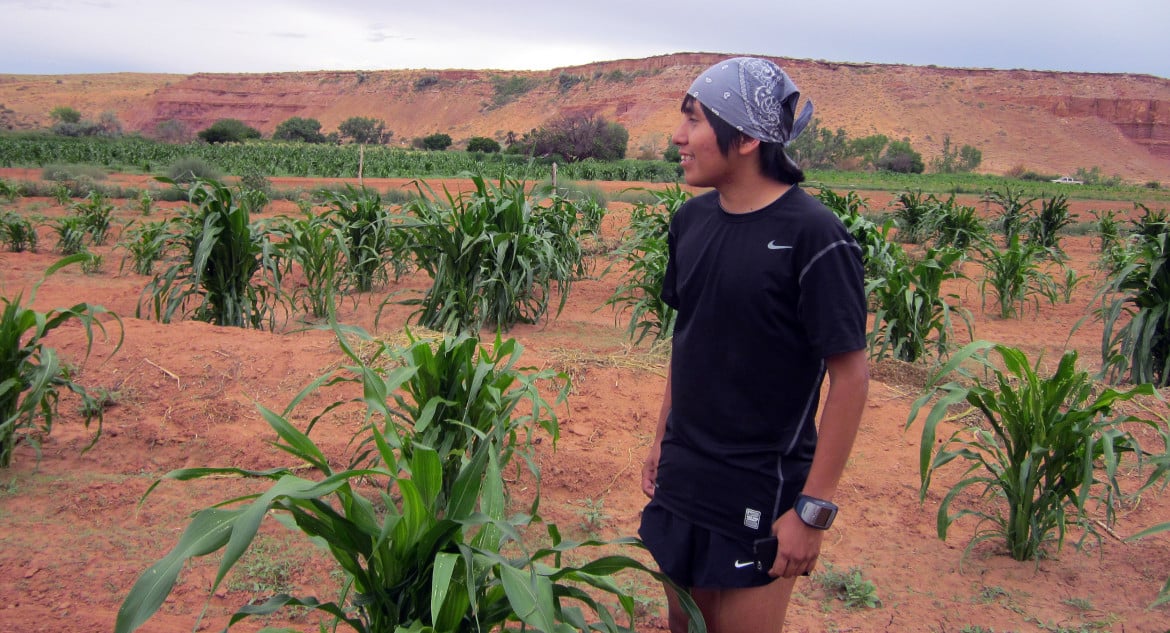
Julie Ann Grimm / Santa Fe Reporter
Dennis Klain was salutatorian of his high school graduating class and a track star. But after a stint at the University of new Mexico, he’s been on a break from school for more than a year and might be in danger of falling through the cracks./figcaption>THIRD MESA, Moenkopi Village, Hopi Reservation – Sand permeates all of life on the Hopi reservation where Dennis Klain grew up. The wind carries the fine, red grains onto every surface, piling up in gutters, landing on pillow cases and sheets, filling shoes no matter whether you walk or run.
It’s here where Dennis was a high school track star, and where three years ago he gave a speech as the salutatorian of the Class of 2011 at Tuba City High School.
He then enrolled in the University of New Mexico in Albuquerque with a financial aid package and a vague goal of one day returning to a job at the Hopi Medical Center. He moved into the dorm and his classes went well the first semester.
But by the spring term, his grades were slipping.
Once poised to beat the odds, 21-year-old Dennis might now be in danger of falling through the cracks. He’s now been on “a break” from school for more than a year. He never enrolled in a degree program, and unpaid tuition and housing bills have accumulated, keeping him from signing up for the next semester.
“I value education,” he said on hot July day last year as he watched short corn stalks sway in the breeze below the village of Moenkopi. “I’m just not sure about school.”
While each of the nation’s more than 500 American Indian tribes is unique in its values, customs and structure, the situation Dennis finds himself in is common. The pursuit of higher education for students like him who grew up on the reservation is not a given.
Only about 7 percent of the adults over the age of 25 in the Hopi territory hold at least a bachelor’s degree, for example, compared to a U.S. average among all American Indians of about 17 percent. Among all adults in the country, the number is about 31 percent.
Insiders say diplomas are elusive for the diverse demographic because of financial hurdles, poor college preparedness in secondary schools and, not least, cultural challenges. Yet there are successful community-building, early preparation and financial aid models that could be turning the tide.
Positive impact
When Pamela Agoyo hears those statistics, she thinks of the words disparaging, unfair and detrimental.
Yet, when she learns Dennis’ story and checks his records with the school, she lets out a short breath.
“On paper, there’s no reason why he had to leave. Something could have been worked out,” says Agoyo, the director and special assistant to the president for American Indian Affairs at UNM.
Without knowing much about him, Agoyo says, on the surface it appears Dennis didn’t connect. He chose not to join the school’s track team so that he could “focus on school” and run alone, he’d said last summer. That means he missed the kind of support system that held up during rough times in high school. He also felt the city didn’t suit him.
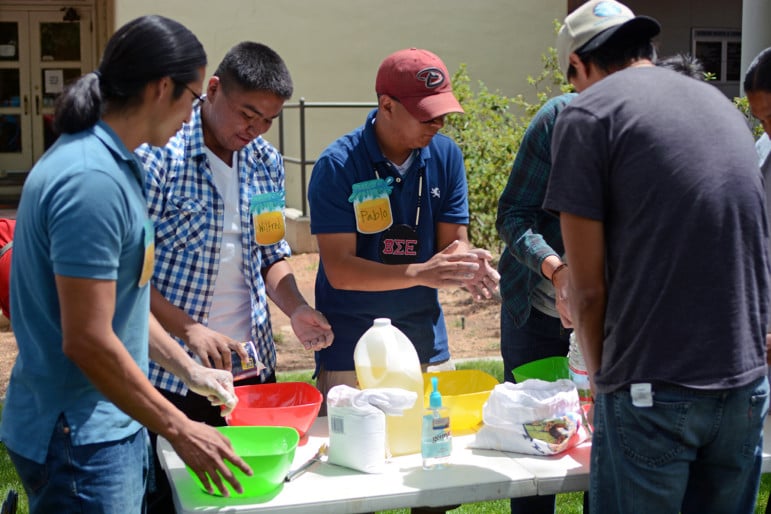
Cole Howard / Santa Fe Reporter
A group of students gathered last week around a table at the University of New Mexico to make fry bread. It was one of the competitions involved in winning the title of “the Mutton King.” The mock male pageant connected current and former students in a playful event full of dancing and laughter. Officials say helping students find community and make friends is key to their staying in school./figcaption>Over the last dozen years at UNM, Agoyo has helped Native students earn degrees. A graduate of the school herself, she’s been through six presidents at the state’s flagship university, diligently teaching each one about the critical relationship between the school and tribal leadership from a number of sovereign nations.
“I feel like it is my job to educate every president that comes on board about the unique opportunity that we have to positively impact the experience of Native students on this campus,” she says.
She also knows many of UNM’s Native students at the school because they regularly meet with advisers, do homework and take advantage of the Wi-Fi at the American Indian Student Services center, where she’s an advocate and a voice of encouragement.
Agoyo, who has Cochiti, Okhay Owingeh and Santa Domingo heritage, is also president of the National Indian Education Association, a 40-year-old organization that advocates for educational excellence and opportunity for Native students. She says there are better ways to measure the success of Native students than relying on the statistics commonly cited.
For example, about 1 percent of the U.S. population is American Indian. Drilling down into New Mexico, 10.2 percent of the state’s population is Native, yet according to enrollment data, the demographic accounts for 14 percent of students at all UNM campuses, including its branch in Gallup near the Navajo Nation and its “twig” campus at Zuni Pueblo.
“So there,” she says, “we are exceeding.”
Persistence rates, which measure how many students reach their third semester, hover around 66 percent for Native students at UNM’s main campus, she says, compared to 78 percent for the student body as a whole. Those numbers are crucial, she says, because they show how many students survive that tough first year, then return.
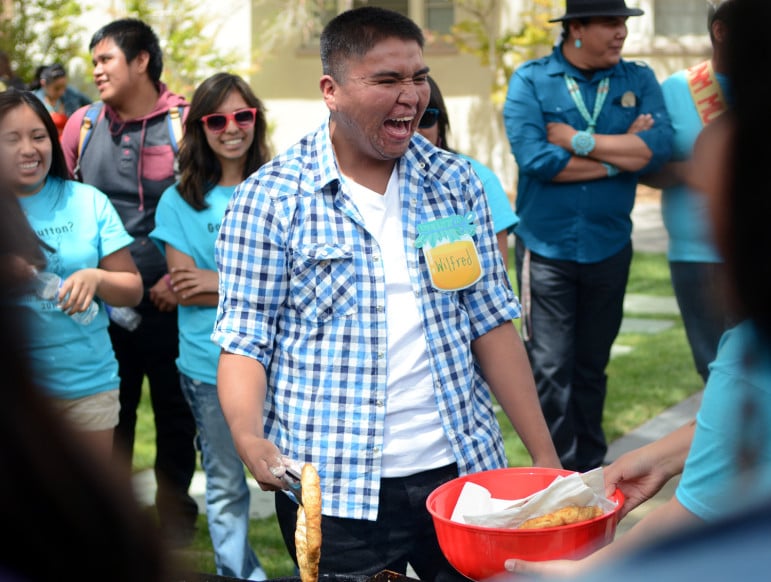
Cole Howard / Santa Fe Reporter
Students gathered around as Wilfred Jumbo eagerly cooked fry bread during last weeks’ competition at UNM./figcaption>One key to persistence is community. For example, many of those students who beat the odds were enrolled in a special summer program between high school and freshman year. Students in the American Indian Summer Bridge Program make friends, get a jump-start on eight college credits, she says, and have a persistence rate of 81 percent.
“They’re not coming here completely green,” she says.
During that month on campus, they learn their way around, meet the staff at the American Indian Student Services and have residential advisers who guide them through the summer programs.
“So, they’re not alone,” she says. “And what we find is that for students, it is easier for them to walk away from an institution than it is for them to walk away from friends.”
UNM junior Contrera Endwarrior, who is Navajo and Oneida (a Wisconsin tribe), says she joined the bridge program just a year after her older brother completed it. Coming to the large urban university after attending high school in Bernalillo – where most of the students were also Native and where classes were significantly smaller – was still a culture shock, even with the extra attention.
Now, the 20-year-old Endwarrior says she is nearly finished with her bachelor’s degree in health education, and she’s looking forward to an internship this summer in California that is part of a Johns Hopkins University program.
What’s made the difference for her?
“Every opportunity I’ve taken advantage of,” she says as she watches other students set up a folding tables in a campus courtyard for the American Indian Student Services spring social event. “Education is what our people need. It’s what the Native communities need. There’s going to be a time when us young people need to step up.”
Many of her peers drop out, she says, because they feel homesick, detached and overwhelmed. In her role as a peer adviser, she says she tries to thwart those strong emotions. “We try to be a home away from home. We try to be a family to them,” she says.
For Agoyo, focusing on why students stay is a better use of time than determining why they leave.
“When people start to say, why are people leaving? What is going on with that? I always flip it and say I think we ought to be looking at why they are staying,” she says. “We can focus in on the areas where we are seeing strengths.”
Still rebounding
Even before the money problem at UNM, Dennis Klain was losing focus. No career track grabbed his attention. He talked about heading toward medical school because other people encouraged him to, but once he was taking classes, his interest waned.
“I just feel lost at times,” he said last July.
Regis Pecos is co-director of the Leadership Institute at the Santa Fe Indian School, a program that takes high school students to Washington, D.C., as they learn about navigating their own political landscapes. He says Dennis’ story is hardly exceptional, but it is tragic — for Dennis, but also for society. Just because people have the ability to succeed, Pecos says, doesn’t mean they can always find a clear pathway forward.
Native communities are still rebounding from abuses that occurred more than 100 years ago, he says, noting that many families still carry the wounds of horrific boarding school experiences. In the late 1800s, U.S. government policies called for forcibly removing Native children from their homes. During the enforcement of those policies, government agents not only ripped apart families, they replaced the generational teaching of elders with assimilation into the “dominant” norms at boarding schools. Children became isolated from their families, religions and traditions.
Even though the mandatory boarding school plan was gone by the 1920s, formal education for Native people in the current public schools system is still inadequate, says Pecos.
Since then, “the narrative hasn’t changed much in terms of where Indian children rank in terms of their academic performance,” he says. “If we are not redefining education for our purposes, it’s going to recreate the boarding school experience.”
Pecos points out that Native kids don’t get inundated with messages about college and typically don’t know many people who have earned formal degrees. He also believes that tailoring college curricula to include Native teachings about the holistic world would naturally address shortcomings in recruitment and retention.
Many Native students face additional challenges even after they’ve decided to attend college. Once there, they can experience isolation, culture shock and the challenge of dealing with city life after a rural upbringing. Pecos knows this firsthand: He left Cochiti Pueblo after high school to become one of just six Native students at Princeton University in the 1970s. Recalling what it felt like to be a cultural pioneer, Pecos says tribal members who go off to college then return home aren’t always warmly welcomed back by peers or family who stayed.
It’s students who end up with the necessary confluence of professors and programs, community and relevance who succeed, he says.
“Without these strands – and without perfectly weaving them along the way,” he said, “you are finding your way in the dark.”
Tracking opportunity
Among institutions that seem to be providing brighter light for Native students are the nation’s 37 tribal colleges. Santa Fe has long been home to the Institute for American Indian Arts. IAIA has been operating since 1962, first on rented and borrowed spaces before moving to its own campus in Rancho Viejo in 2000.
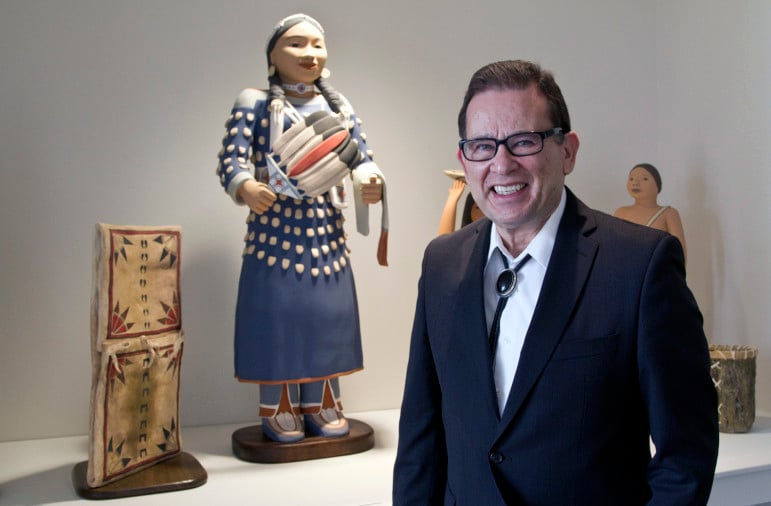
Mark Woodward / Santa Fe Reporter
Institute for American Indian Arts President Robert Martin says a rise in enrollment is proof that tribal colleges are providing good access to higher education for Native students./figcaption>This spring, students are replanting a community garden that faces circular gathering spaces used for dances and ceremonies. Campus corridors reveal art projects around every corner: Tiny pots printed in the school’s 3-D lab fill a glass display case, while another hallway features larger-than-life paintings that mix traditional images with graphic, modern ones.
The school is chartered by the U.S. Congress, and its enrollment is on the rise with a peak last year of 344 full-time equivalent students, about 75 percent of whom are Native.
President Robert Martin says that’s simple proof that tribal colleges, which built steam around the same time as American Indian Movement, or AIM, and the Red Power movement in the 60s, are providing good access to higher education for Native students. A member of the Cherokee Nation, Martin wears close-cropped hair and speaks with a faint accent from his upbringing near Appalachia.
For decades, Native students have been “tracked” in public schools, with well-meaning counselors who advised them to enter arts and crafts and other jobs for people who are “good with their hands,” he says.
“That is now changing and a lot of students don’t accept that anymore,” says Martin. “Counselors and high school staff are being much more positive in terms of advising Native high school students, but you don’t change those things overnight. It takes time.”
Martin agrees with Pecos that the historic tie between higher education and efforts to assimilate Indians into Anglo culture still affects the way many Native communities perceive education. But that is changing too, he says. Economic development on reservations is creating job opportunities and a demand for people with degrees and training.
“They are able to go back home,” he says, “and see that an education can help to actually maintain the culture and to promote and maintain tribal sovereignty and self-determination and native languages.”
Planting the seed that college is a good plan has to start earlier, he says. That’s one reason IAIA offers dual credit in college courses for high school students, including those enrolled at the Santa Fe Indian School and New Mexico School for the Arts.
“We are trying to reach high school students and allow them to have some success in college so they are more likely to think, ‘I’ve been successful,’” Martin says. “We have had some people leave high school with 12 to 15 hours [of college credit], and they feel like they are given the confidence to go on.”
Yet, it’s not confidence that many students cite as their big hurdle. It’s money.
“You can leave home and get Pell grants, but what about food and clothes? What about computers and books?” says Nocona Burgess, student activities coordinator for IAIA. “Those things don’t pay for everything.”
Native kids disproportionately come from poor communities where schools don’t adequately prepare them for college; then, once in college, they have a hard time keeping up with costs. More than 28 percent of American Indians live below the poverty line, the U.S. Census reports, compared to the national poverty rate of 15.3 percent.
Burgess, a member of the Comanche Nation, agrees that the double punch of economic disadvantage and cultural challenges contributes to Native students not making it all the way through college.
“I think a lot of it is about economics,” says Burgess. “And also it’s about the connection to home. … It’s hard to leave home.”
His own educational experience could have been a story of infinite incompletion, too. He was enrolled at the University of Oklahoma, his dad’s alma mater, to become an architect. But he visited Santa Fe one summer, got hooked on IAIA and transferred there.
An education focused on Native artists and thinkers was attractive to Burgess.
After earning an associate’s degree and transferring to UNM, however, he got sucked into a full-time job at a casino. Years passed, and he painted less and less. But he eventually got himself back on track and earned a bachelor’s degree from the University of Science and Arts of Oklahoma. Today, as he completes a master’s degree in arts in education at UNM, his work hangs in the Giacobbe-Fritz Gallery on Canyon Road as well as the Smithsonian’s National Museum of the American Indian. He’s featured in the April issue of Southwest Art magazine.
Burgess’ job at IAIA includes “kind of entertaining [students] and also kind of expanding their training outside the classroom,” with trips to museums, galleries and sports activities. “They are just like any group of American kids,” he says. “They are dealing with the same things.”
Many students say they’ll take time off to work and repay debt, but not all return. IAIA even has an emergency fund to help students regain footing when there’s a family problem back home or a student is in danger of quitting because of late rent or a car payment.
Burgess owes some of his success to his parents. They expected him to earn a degree, he says. And now, he expects that of his own son, now 4 years old.
“Everybody should have the opportunity economically if they want to go to college,” he says. “You almost can’t do the old-school way if you just want to be a worker. The way the gap is, you can’t. You need to do some kind of training in order to succeed. Our country isn’t built like that anymore.”
Paying for it
Tribes are increasingly pitching in for college funding, but not in a way that makes a big dent, says UNM’s Agoyo. In a recent meeting between UNM President Robert Frank and tribal leaders from New Mexico, several non-gaming tribes inquired about additional scholarship money for students.
Just across New Mexico’s western border, Arizona’s Hopi Tribe uses revenue from mineral extraction on its lands to establish an endowment fund for scholarships. There’s not enough to go around, however.
Kathlene Sumatzkuku, also a native of Moenkopi who got assistance from the tribe for her own education, is program administrator for grants and scholarships. The tribe receives about 300 applications for funding each year, and is able to award cash to about half those students, she said in a summer interview. Even those students — like Dennis — aren’t fully funded. While the tribe’s endowment is $10 million, officials only send about $250,000 from the fund’s earned interest out the door each semester.
By contrast, at Pojoaque Pueblo north of Santa Fe, gaming revenues and other business ventures have enabled the tribe to provide full-ride assistance to students at all levels. More than 50 tribal members have earned college degrees through the program since 1989 that amounts to more than $1 million in spending every year, says Gov. George Rivera.
“This is not just an issue of Native kids,” Rivera says. “You are going to find bigger success stories where parents and the community are paying attention to education and participating in it, and you are going to find problems where there is a lot of poverty and less focus on education because the basic necessities of life aren’t assured every day.”
While many recent college graduates have returned to the pueblo and are working in business and government, not everyone has returned. Yet the enthusiasm for education is catching, he says. Dozens of students from the pueblo attend private school at Santa Fe Prep; graduates of places like Dartmouth and Stanford have more alumni company each year at home; and adults from the tribe are also returning to college, or in many cases, enrolling for the first time.
“A lot of tribal members are challenging themselves and making the pueblo a better place,” Rivera says. “You’ve got to look at the historical picture of the pueblo, when there was very high poverty and high addiction. Education is one of the cures for sure to get out of that kind of a hole.”
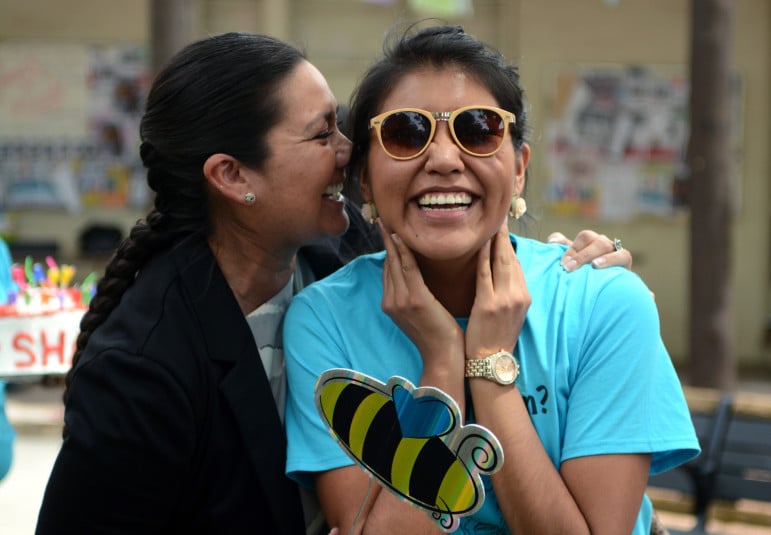
Cole Howard / Santa Fe Reporter
Pamela Agoyo, director of the American Indian Student Services center at UNM, informed student Shawna Nelson that there was a surprise birthday cake for her during a student event on campus last week. Nelson was celebrating her 23rd birthday./figcaption>Back at UNM, Agoyo says opportunity exists for financial help too, but many students need extra urging to apply for scholarships.
“I see over and over again the lost opportunity to garner additional funds because students and families are applying really late,” she says, noting that she’s “a lot of times begging students to apply for scholarships.”
Somewhere in the equation, she says, students have to take the first step to seek help. “They get to choose.”
Agoyo says that she has a standard speech for students. She knows where they came from and what they are facing.
“I tell students all the time that our ancestors gave up a lot so that we could be here. Many of them gave their lives. … They prayed all the time that things would be better because they lived in a time when things, the outlook, was real, real bleak,” she says. “So these sunny days have come and we are not necessarily being grateful for them, right? We are passing up these opportunities.”
This article really bothered me. And I agree with the other commenter that there was not enough from Dennis, too much of what others think about college and their education. College is not for every person and certainly not at the same time on the same schedule.
I have a lot of college education but when I look at the photo of Dennis in the amazing corn field, it is obvious that he has a lot to teach me. The sight of a Hopi cornfield is so beautiful and represents an old, wise agri-culture.
I would like to have heard more from Dennis. His story, from him. I get the sense Dennis understands what education is better than those who run colleges, teach at colleges, and strive to uphold degreed, institutional training as some kind of “higher education,” when in reality it is far from it. The traditionalist Hopi, like my Gaelic ancestors, had a lifestyle and an understanding that provided an opportunity for education that is beyond the imaginative ability of most modern people who have been trained up and I’m sorry to say, dumbed down, by institutional training. To educate means “to grow out from one’s self.” Not to have in-formation. All true education is self education. I know there is great value and empowerment placed on the individual who joins the program, does the programming, submits great energy and belief, and attains the “degree.” But in truth it is little more than a scam. A great illusion. And at what price?
We need more emphasis on education, more recognition of what true education is, and less elitist club member type degree worshiping and mental training we find in institutional learning systems. All education is self education. Live naturally. Learning is a full time, lifelong process. It does not happen only in classes, semesters, or trimesters. It happens every waking moment of consciousness. It is not what is written or read that educates, but what is remembered. Who does the remembering? How? And why?